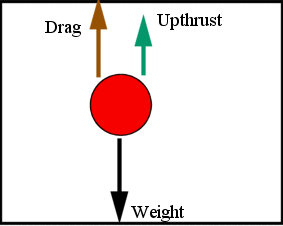Types of Forces - Gravitational, Electric, Frictional, Viscous drag and Upthrust
In this post, we’ll try to look at a
summarized explanation of some different types of forces, namely (as requested
by one of the visitors) Gravitational force, Electric force, Frictional force,
Viscous drag and Upthrust.
Quick
Introduction:
- Force may be described as a pull or a push that causes a body to accelerate (change the velocity of the body).
- Force is defined as the rate of change of momentum.
- Force is a vector quantity – it has a magnitude and a direction. SI unit: Newton (N)
- Related topics: Newton’s law of motion, Equilibrium, …
All of the forces in the universe
are based on 4 fundamental interactions (gravitational
force, electromagnetic force [electric force is part of this] and nuclear
forces [strong and weak]). {Currently,
physicists are trying to unify (to explain them as a single concept) these
fundamental forces, some of them have been unified, but not all.}
All other forces in nature are derived from these 4 fundamental interactions. Consider, for example, the frictional force. At the atomic level, friction is a manifestation of the electromagnetic force acting between the atoms of 2 surfaces, and the Pauli exclusion principle (for A-level, do not this mind) which does not permit atoms to pass through each other.
The other forces can also be
explained using similar concepts.
Contact forces and Forces that can act at a distance
Forces may be of 2 types: Contact
forces and forces that can act at a distance from the object. Of the
forces discussed below, frictional force, viscous drag and upthrust are
examples of contact forces while gravitational force and electric force can act
on the mass or charge without being in contact with them.
For such forces (gravitational or
electric) to act, the body (mass or charge) should be in the corresponding
field (gravitational field or electric field). A field of a force may be
defined as a region (in space) where a particle / body experiences a force.
Gravitational Force
Gravitational force is the force experienced by a mass in the gravitational field of another mass. Gravitational force is always attractive, is directly proportional to the product of masses and inversely proportional to the square of the separation of the masses. [F = GMm / r2]
(More information on gravitational force can be found as
question 35 at Physics 9702 Doubts | Help Page 6 - http://physics-ref.blogspot.com/2014/11/physics-9702-doubts-help-page-6.html)
Electric Force
Electric force is the force experienced by a charge in the electric field of another charge. Electric force can be either attractive (unlike charges attract) or repulsive (like charges repel). Electric force is directly proportional to the product of charges and inversely proportional to the square of the separation of the charges. [F = Qq / (4πϵor2)]Frictional Force
Frictional force is a surface force (exerted by surface) that opposes relative motion. It is related to the normal force, R by Frictional force = μR where μ is the coefficient of friction.
Consider a box on a
surface. The weight of the box acts on the surface and from Newton’s third law,
the surface also produces a force, perpendicular to the surface, on the box.
This is the normal force. If the surface is horizontal, the normal force is
equal to the weight, but if the surface is inclined, the normal force is equal
to the perpendicular component of the weight to the surface.
(More information on frictional force can be found as
question 36 at Physics 9702 Doubts | Help Page 6 - http://physics-ref.blogspot.com/2014/11/physics-9702-doubts-help-page-6.html)
Viscous Drag
Viscous drag (drag or fluid resistance – for air, it is air resistance) is a type of friction in fluids (liquids and gases) that opposes the relative motion of an object {if there is no motion in the fluid, viscous drag is zero} with respect to the surrounding fluid. Viscous drag, unlike dry friction, highly depends on velocity.
Different fluids have
different viscosity, which affects the viscous drag. Consider a ball dropped in
water and in oil. The motion of the ball
in water is quicker than in the oil. So, the viscous drag in oil is more than
in water.
Upthrust
Upthrust (buoyancy) is an upward force exerted by a fluid, opposing the weight of an immersed (or floating) object. This force arises due to the difference in pressure between the upper and lower surfaces of the object. {This force causes a person to float on sea water.} From Archimedes’ principle, the upthrust is equal to the weight of the fluid displaced by the submerged object.
Other forces: centrifugal force, thrust,
tension, elastic force, coriolis force, centripetal force, …
(Note that this is a quick and
incomplete explanation on some different forces. Details of the forces may be
explained later. For A-level, calculations for the frictional force, viscous
drag and upthrust are not required.)
References:
http://en.wikipedia.org/wiki/Force
http://en.wikipedia.org/wiki/File:Stokes_sphere.svg
http://en.wikipedia.org/wiki/File:Gravity_action-reaction.gif
http://en.wikipedia.org/wiki/Electric_charge
http://en.wikipedia.org/wiki/File:Friction_relative_to_normal_force_%28diagram%29.png
http://www.antonine-education.co.uk/Salters/EAT/Flow.htm
http://www.bbc.co.uk/bitesize/ks3/science/energy_electricity_forces/forces/revision/5/







No comments:
Post a Comment
If it's a past exam question, do not include links to the paper. Only the reference.
Comments will only be published after moderation